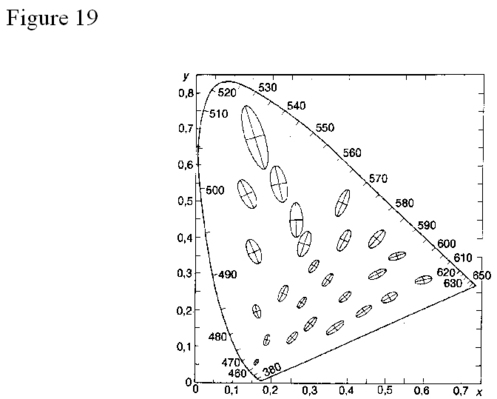
Systems CIELAB and CIELUV
The eye's ability to separate two distinct colors depends of the hue, saturation and brightness of the observed color. As a consequence, the sensitivity to color differences will vary from one region to another within the CIExy diagram. Many studies have tried to study these variations: Mac Adam [] defined 25 points, spread out inside the (x,y) diagram, around which he drew ellipses with different sizes and orientations: all the colors inside an ellipse appear to be matched with the central color of the ellipse for a standard observer (see figure 19).

In the
 diagram, colors which appear to be different “by the same amount” are represented in the diagram as dots separated by very different distances depending on the color hue, which means that the (xy) space is not uniform. Transformations of the color space CIE XYZ 1931 have been proposed in order to obtain a better correlation between the “color difference” (as perceived by an observer) and the length separating two representative points.
diagram, colors which appear to be different “by the same amount” are represented in the diagram as dots separated by very different distances depending on the color hue, which means that the (xy) space is not uniform. Transformations of the color space CIE XYZ 1931 have been proposed in order to obtain a better correlation between the “color difference” (as perceived by an observer) and the length separating two representative points.
Chromatic space L*u*v* 1976 (CIELUV)
n 1976 the Commission Internationale de l'Eclairage (CIE) has defined a nearly uniform chromatic space by defining two coordinates
 and
and
 such as :
such as :
with
 is the CIE 1976 lightness [] defined by
is the CIE 1976 lightness [] defined by
 if
if
 or
or
 if
if
 .
.
 ,
,
 and
and
 stand for the values of
stand for the values of
 ,
,
 and
and
 for a given illuminant (see examples in table1):
for a given illuminant (see examples in table1):

The CIE recommends using the CIELUV color space for the characterization of color displays.
Chromatic space L*a*b* 1976 (CIELAB)
The CIELAB space is obtained by representing in a Cartesian coordinates system the parameters
 and
and
 defined by :
defined by :
with
and
 has the same definition as in the CIELUV color space.
has the same definition as in the CIELUV color space.
 ,
,
 and
and
 are the values of
are the values of
 ,
,
 and
and
 corresponding to the illuminant, as tabulated in table 2:
corresponding to the illuminant, as tabulated in table 2:

The CIE recommends using the CIELAB color space for the characterization of colored surfaces and dyes.